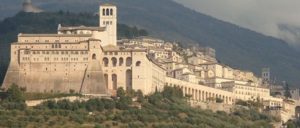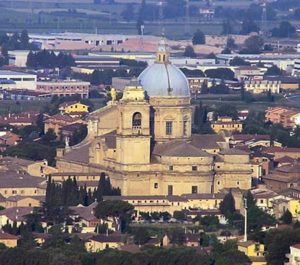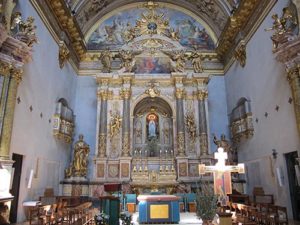by Lauren O. Thyme
 Three hours from Rome, off the main motorway between Perugia and Florence, is the small enchanting hill-town of Assisi. Seen from the valley below, Assisi seems to emerge like a medieval mirage of light and shadow on the steep hill. One needs to navigate the sharply spiraling road to the top, where centuries-old buildings of pink-tinted stone glisten in the late afternoon sun. Although Assisi is renown as the birthplace of St. Francis (portrayed in the movie, “Brother Sun, Sister Moon”) in 1181 AD, Assisi was occupied by Neolithic people, Etruscans, and Romans before Italy became a country.
Three hours from Rome, off the main motorway between Perugia and Florence, is the small enchanting hill-town of Assisi. Seen from the valley below, Assisi seems to emerge like a medieval mirage of light and shadow on the steep hill. One needs to navigate the sharply spiraling road to the top, where centuries-old buildings of pink-tinted stone glisten in the late afternoon sun. Although Assisi is renown as the birthplace of St. Francis (portrayed in the movie, “Brother Sun, Sister Moon”) in 1181 AD, Assisi was occupied by Neolithic people, Etruscans, and Romans before Italy became a country.
I had planned a three-month long trip to sacred sites in Italy, Greece, Crete and Egypt. Last year I uncovered a new ability to “dowse” maps for sacred sites, so I got out a map to determine where power places were located in Italy. Assisi was one of four places I intuited, along with the Baptisteries in Florence and Pisa, and a long stretch of land near the eastern coast of Italy, the ancient Etruscan territory of Etruria (now Tuscany). Consequently, I planned to stay in Assisi a week, arriving by train but later rented a car to wander further afield.
On my many treks to sacred places around the world, I have intuited that threads of energy weave themselves throughout the earth along what are popularly called “ley lines.” These ley lines can be likened to acupuncture meridians, connecting all sacred sites on the earth’s body to each other. Although ancient locations like Stonehenge, Callanish, Delphi and the Giza plateau are part of the global meridian, I looked forward to uncovering other, less ancient places in hitherto unacknowledged regions. Assisi turned out to be one of them.
Although Assisi doesn’t contain standing stones, stone circles or pyramids, it includes many Roman Catholic churches, cathedrals and chapels with significant spiritual capacity. Some “experts” say that the young Christian Church wished to convert local “pagans” to the new religion, by building on original sacred locales while incorporating non-Christian myths and holidays into the early religion. Perhaps the early Christians practiced “earth mysteries” and located many of their churches on sites that for eons had been considered holy and consecrated. Or maybe “shaman-priests” of the infant religion intuited the energy fields that flowed through these regions.
The holy mountain, Mt. Subaso, looks down upon the region surrounding Assisi, blessing the area with its power and grace. Covering many miles, from the valley below the town to the rolling hills and farms around it, divine energy can be felt throughout the whole Assisi territory. St. Francis received the stigmata at nearby Mt. Verena.
Grace is an appropriate word for Assisi. The town seems to be lavishly endowed with grace, not only natural grace emanating from the beautiful green meadows, sparkling brooks, crystal-clear sky, and lush farmland, but contains omnipresent tranquility in the buildings, the people, and the very air one breathes. The peace in Assisi is pervasive, all-encompassing. Even on weekends when throngs arrive to see the town that St. Francis made famous, Assisi embodies an aura of serenity and contentment I have rarely found elsewhere. Time seems to slow down there, while people leisurely stroll through myriads of narrow winding cobble-stoned streets, enjoy Italian cuisine in its many restaurants, or sit chatting by a bubbling fountain, all in an attitude of relaxation and composure. While visiting there, the hubbub of modern life is forgotten.
The grace of Assisi also incorporates unconditional love, much the same way that St. Francis loved animals and birds, indeed all living beings. Francis promoted peace, restoration of order and ecumenical forbearance, while the Church was waging bloody crusades. Assisi was the first town in 11th century Italy where serfs were freed from their onerous bondage. Today religious leaders from all over the world meet here for peace conferences. I’m not surprised that an ordinary man became a saint in Assisi!
I and my companions felt “blissed out” during our stay in Assisi. We were easily transformed from travelers to pilgrims, as we sat on our patio staring at the lovely rolling hillsides in a deep state of meditative rapture. We took a lot of naps, too, awakening in carefree sensibility, without worry or hurry.
 I found two places that contain vast spiritual energy. One was the Basilica of Santa Maria Degli Angeli in the valley below. The long, pious tradition of the site dates back to the beginning of the 1st century AD when four pilgrims returned home from the holy land, inserting a stone into one of the walls, the stone allegedly from the tomb of Mary, the Madonna. When Francis saw the church, it was crumbling into ruins. Due to a vision he received there from angels, Francis restored the church and used it extensively. He is reputed to have died there. Prior to death he requested that he be buried in unconsecrated ground along with heretics and those who had been excommunicated. Since canonization, his mortal remains were exhumed and now are preserved in the Basilica of St. Francis.
I found two places that contain vast spiritual energy. One was the Basilica of Santa Maria Degli Angeli in the valley below. The long, pious tradition of the site dates back to the beginning of the 1st century AD when four pilgrims returned home from the holy land, inserting a stone into one of the walls, the stone allegedly from the tomb of Mary, the Madonna. When Francis saw the church, it was crumbling into ruins. Due to a vision he received there from angels, Francis restored the church and used it extensively. He is reputed to have died there. Prior to death he requested that he be buried in unconsecrated ground along with heretics and those who had been excommunicated. Since canonization, his mortal remains were exhumed and now are preserved in the Basilica of St. Francis.
Entering the Basilica of Santa Maria Degli Angeli, I experienced the standard “goosebumps” and “hair raising” I feel every time I visit a sacred place. Then I felt compelled to go through a narrow doorway. Leading where? I followed the corridor, turned a corner and came to a statue of St. Francis. The less than life-sized statue was set on a pedestal in a grotto, decorated with ivy and flowers. He stood with his hands together in a gesture of supplication. To my amazement I saw a white dove nesting in his hands. Since the statue was erected, generations of doves have made his hands their home. I continued on until I came to the Chapel of the Roses. I felt as though I was bathed in unconditional love there and impulsively prostrated myself upon the mosaic of the cool marble floor. Next to the Rose Chapel was the rose garden, where St. Francis is said to have rolled in the briar patch for penitence. Ever since that time, roses grow there, the unusual leaves stained red while the stems have no thorns.
 The second place that was full of holy intensity was the Temple of Minerva. Its columned facade is the last remnants of a Roman Temple in Assisi, while a Catholic sanctuary was later built inside. I could sense gratitude and blessings filling the holy place, emanating from the altar, the beautiful frescoes, the ceiling. Gratitude is something I have been practicing faithfully, while I had recently learned about Egyptian blessings in the form of baksheesh. Thus, when I left, I contributed liberally to the donation box designated for the chapel’s restoration.
The second place that was full of holy intensity was the Temple of Minerva. Its columned facade is the last remnants of a Roman Temple in Assisi, while a Catholic sanctuary was later built inside. I could sense gratitude and blessings filling the holy place, emanating from the altar, the beautiful frescoes, the ceiling. Gratitude is something I have been practicing faithfully, while I had recently learned about Egyptian blessings in the form of baksheesh. Thus, when I left, I contributed liberally to the donation box designated for the chapel’s restoration.
I encountered another form of sacred site while at Assisi – people.
The first person was a young man, Giancarlo Boccini, who owns a museum in Assisi. He has worked for seven years, constructing a miniature town of Assisi the way it would have looked in St. Francis’ time. He created the miniatures with the same materials that had been used back then — local pink stone for the buildings, cobblestones for the streets, granite for the fountains, clay tiles for the roofs and tiny flower pots that grace the glass windows of the doll-sized houses. You could see into the homes, barns, and churches with “townspeople” eating, praying, shoeing horses and other daily 12th century activities, all appropriately dressed. He has even perfectly reproduced (by hand) a small copy of the elaborately painted and gilded fresco from the outside of the Basilica of Santa Maria Degli Angeli! I was fascinated with the museum, partly because while in Rome I had a vision of creating a “sacred site museum,” but also because I wondered why he had undertaken such a huge task. When I talked to Giancarlo about his work, he modestly waved aside all my compliments, although he did mention that a TV station in Rome (similar to PBS) had aired a program on his museum. When I candidly asked Giancarlo if St. Francis had inspired him to do the work, he humbly replied, “Yes,” and seemed surprised at my discerning question.
The second was a family on the outskirts of Assisi. My boyfriend Paul and I had taken a hike through the dusty back lanes and found their farm, complete with grape arbors, vegetables, sheep, goats, pigs and chickens. We sat under a tree in an untilled portion of their land, gazing at a field thickly blanketed with blooming wildflowers. When we returned to the lane past their house, two elderly people and a darling little boy were standing at their gate. We all smiled and nodded. They spoke no English and we only spoke a smattering of Italian but we seemed to make ourselves understood anyway. I asked the boy’s name. “Alessandro.” I bent over and said “Buon giorno, Alessandro,” but he hid timidly behind his grandmother’s long dress. Paul and I held up fingers to indicate how many children and grandchildren we each have and they understood completely. I enthusiastically indicated their property and said, “Molto Bella,” (quite beautiful), and they smiled proudly. The old man then indicated we should wait while he went up to his house. He returned with a carafe of home-made wine and poured us each a glass. We toasted each other’s health with his delicious wine. Then I took a picture of Alessandro and his grandmother and we left, the old Italian couple waving at us until we were out of sight. They taught me how friends can be made anywhere, even without a common language.
The third sacred person was a nun my friends and I met in front of one of the many churches in Assisi. Sister Cely was dressed all in white and she glowed with an inner brilliance of love and joy, making her seem much taller than 4’11”. She was taking pictures of the church and we did the same. We chatted and giggled like old friends, taking pictures of each other with the church in the background. Then she invited us to see her convent at the other end of town. It didn’t matter that we weren’t Catholics!! On the way there, she told us that her job was to care for the elderly nuns, to nurse them when they were old and bedridden. She told us she feels blessed to perform this task and does it happily. From the top of the convent, the valley of Assisi lay before us like a colorful tapestry and together we watched the sun begin to set. Sister Cely and I still correspond and every letter from her is filled with unconditional love, nurturing words, and sincere prayers for me and my family. I feel blessed to have met her, an angelic being in human form.
Pope John XXIII, in a pilgrimage to the tomb of St. Francis in 1962, summed up our experience of Assisi most poetically. “…We ask ourselves: why did God give Assisi this enchantment of nature, this aura of sanctity, almost suspended in the air, which the pilgrim almost tangibly feels? To answer is simple. So that men [and women], through a common and universal language, will learn to recognize the Creator, and to recognize each other as brothers [and sisters].”
About the author:
Lauren O. Thyme is a spiritual and psychic counselor, healer, channel, lecturer, published writer and poet, and spiritual traveler. She is the author of several books. To see them all on Amazon, Click Here.
This article was originally published in the October/November 1998 issue of Power Trips magazine.
Watch a video about Assisi, Italy travel